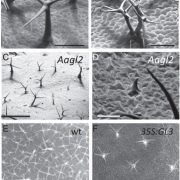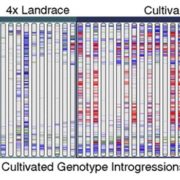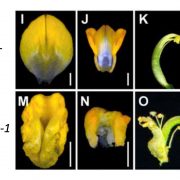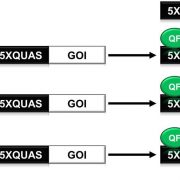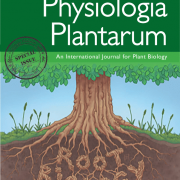Transcription factor interplay between LEAFY and APETALA1/ CAULIFLOWER during floral initiation
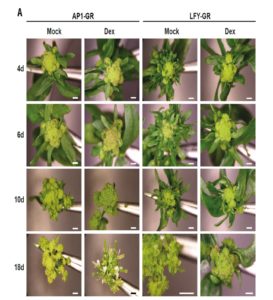 Several transcription-factor encoding genes involved in the transition from vegetative to reproductive growth have been identified. One of these, LEAFY (LFY), is expressed at the flanks of the inflorescence meristem at the site of newly forming floral meristems; loss-of-function lfy mutants produce leaves instead of flowers. APETALA1 (AP1) and CAULIFLOWER (CAL) are related genes expressed very early in floral meristem development; loss-of-function of both genes leads to an overproliferation of inflorescence meristem tissue, forming an apex that resembles a cauliflower. Goslin et al. looked at gene expression in a plant in which LFY was activated by fusion to the glucocorticoid receptor (LFY-GR) in an ap1/cal mutant background. Specific LFY targets in the mutant and wild-type background were compared, and compared to results from an AP1-GR study, to examine the regulatory interplay between these transcription factors. Although both genetic and molecular evidence suggest that LFY and AP1/CAL act in a partially redundant manner in floral meristem specification, some of their gene targets show antagonistic regulation. The authors suggest a model in which LFY and AP1/CAL form an incoherent feedback loop; “by providing positive as well as negative inputs, LFY might ensure that flower development can commence only when AP1/CAL levels are sufficiently high to efficiently activate the expression of other key floral regulators.” Plant Physiol. 10.1104/pp.17.00098
Several transcription-factor encoding genes involved in the transition from vegetative to reproductive growth have been identified. One of these, LEAFY (LFY), is expressed at the flanks of the inflorescence meristem at the site of newly forming floral meristems; loss-of-function lfy mutants produce leaves instead of flowers. APETALA1 (AP1) and CAULIFLOWER (CAL) are related genes expressed very early in floral meristem development; loss-of-function of both genes leads to an overproliferation of inflorescence meristem tissue, forming an apex that resembles a cauliflower. Goslin et al. looked at gene expression in a plant in which LFY was activated by fusion to the glucocorticoid receptor (LFY-GR) in an ap1/cal mutant background. Specific LFY targets in the mutant and wild-type background were compared, and compared to results from an AP1-GR study, to examine the regulatory interplay between these transcription factors. Although both genetic and molecular evidence suggest that LFY and AP1/CAL act in a partially redundant manner in floral meristem specification, some of their gene targets show antagonistic regulation. The authors suggest a model in which LFY and AP1/CAL form an incoherent feedback loop; “by providing positive as well as negative inputs, LFY might ensure that flower development can commence only when AP1/CAL levels are sufficiently high to efficiently activate the expression of other key floral regulators.” Plant Physiol. 10.1104/pp.17.00098


